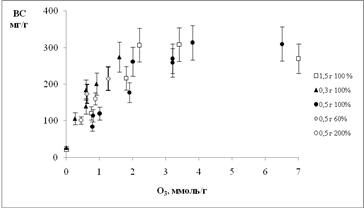OZONE PRETREATMENT OF LIGNOCELLULOSIC MATERIALS: THE EFFECT OF OZONE CONSUMPTION ON REACTIVITY IN ENZYMATIC HYDROLYSIS INTO SUGAR
UDC 543.422:628.3
Abstract
Ozonolysis, as a lignocellulosic biomass pretreatment for sugars and bioethanol production is becoming widespread in recent years owing to its efficiency and environmental safety. Ozone reacts preferably with lignin than carbohydrates, leading to biomass delignification, and so the sugar release by enzymatic hydrolysis. Sugars yield depends on ozone pretreatment parameters and additional studies are necessary to optimize the process to achieve high yields with economic feasibility.
In this work some general patterns of ozone pretreatment are established, using the samples of plant biomass of various types (straw, soft and hardwood). It is shown that the reactivity of vegetable substrates pretreated with ozone is determined by the amount of ozone consumed and practically does not depend on the conditions under which this value of ozone consumption was achieved. The optimal value of ozone consumption, which allows to obtain the maximum yield of sugars in the enzymatic reaction, is 2–3 eq. O3/C9PPU (in terms of phenyl-propane structural unit of lignin, contained in the raw material) or 10–15 wt.%. Intermediate ozonation products do not exhibit inhibitory properties at such ozone consumption.
Downloads
Metrics
References
Binder A., Pelloni L., Fiechter A. Eur. J. Appl. Microbiol. Biotechnol., 1980, vol. 11, pp. 1–5, DOI: 10.1007/BF00514070.
Neely W.C. Biotechnol. Bioeng., 1984, vol. 26, pp. 59–65.
Vidal P.F., Molinier, J. Biomass, 1988, vol. 16, pp. 1–17.
Travaini R., Martín-Juárez J., Lorenzo-Hernando A., Bolado-Rodríguez S. Bioresour. Technol., 2016, vol. 199, pp. 2–12, DOI: 10.1016/j.biortech.2015.08.143.
Ben’ko E.M., Manisova O.R., Lunin, V.V. J. Phys. Chem. A, 2017, vol. 91, pp. 1117–1123, DOI: 10.1134/S0036024417070056.
Fengel' D., Vegener G. Drevesina: khimiya, ul'trastruktura, reaktsii. [Wood: chemistry, ultrastructure, reactions]. Mos-cow, 1988, 512 p. (in Russ.).
Somogyi M. J. Biol. Chem., 1952, vol. 200, pp. 200–245.
Sinitsyn A.P., Chernoglazov V.M., Gusakov A.V. Metody issledovaniya i svoystva tsellyuloliticheskikh fermentov. [Re-search methods and properties of cellulolytic enzymes]. Moscow, 1990, vol. 25, pp. 30–37. (in Russ.).
Bailey P.S. Ozonation in Organic Chemistry. New York, 1982, vol. 2, 516 p.
Gierer J. Holzforschung, 1982, vol. 36, pp. 55–64, DOI: 10.1515/hfsg.1982.36.1.43.
Olkkonen C., Tylli H., Forsskåhl I., Fuhrmann A., Hausalo T., Tamminen, T.,Hortling B., Janson J. Holzforschung, 2000, vol. 54, pp. 397–406, DOI: 10.1515/HF.2000.067.
Ragnar M., Eriksson T., Reitberger T. Holzforschung, 1999, vol. 53, pp. 423–428.
Ben’ko E.M., Manisova O.R., Lunin V.V. Russ. J. Phys. Chem. A, 2013, vol. 87(7), pp. 1108–1113, DOI: 10.1134/S0036024413070091.
Ben’ko E.M., Chukhchin D.G., Mamleeva N.A., Kharlanov A.N., Lunin V.V. Russ. J. Phys.Chem. A, 2020. (accepted for publication).
Ben’ko E.M., Chukhchin D.G., Lunin V.V. Russ. J. Phys. Chem. A., 2017, vol. 91(11), pp. 2092–2097. DOI: 10.1134/S0036024417110036.
Mamleeva N.A., Autlov S.A., Bazarnova N.G., Lunin V.V. Pure Appl. Chem., 2009, vol. 81, no. 11, pp. 2081–2091, DOI: 10.1351/PAC-CON-08-10-11.
Hoigne J. Hand book of ozone technology and Applications. Ann. Aiber Science Publisher. M.I., 1982, vol.1.
Nompex P., Dore M. Ozone Sci. Eng., 1991, vol. 13, no. 3, pp. 265–286, DOI: 10.1080/01919519108552467.
García-Cubero M.T., Palacín L.G., González-Benito G., Bolado S., Lucas S., Coca M. Bioresour. Technol., 2012, vol. 107, pp. 229–234, DOI: 10.1016/j.biortech.2011.12.010.
Ben’ko E.M., Chukhchin D.G., Lunin V.V. Russ. J. Phys.Chem. A, 2020. (accepted for publication).
Bule M.V., Gao A.H., Hiscox B., Chen S. J. Agric. Food Chem., 2013, vol. 61, no. 16, pp. 3916–3925, DOI: 10.1021/jf4001988.
Kobayashi M., Asano T., Kajiyama M., Tomita B. J. Wood Sci., 2005, vol. 51, no. 4, pp. 348–356, DOI: 10.1007/s10086-004-0664-9.
Marcq O., Barbe J.M. Carbohydrate Research, 2009, vol. 344, pp. 1303–1310, DOI: 10.1016/j.carres.2009.05.012.
Mamleyeva N.A., Autlov S.A., Kharlanov A.N., Bazarnova N.G., Lunin V.V. Zhurnal fizicheskoy khimii, 2015, vol. 89, no. 8, pp. 1298–1304, DOI: 10.7868/S004445371508021X. (in Russ.).
Sugimoto T., Magara K., Hosoya S., Oosawa S., Shimoda T., Nishibori K. Holzforschung, 2009, vol. 63, pp. 537–543.
Mamleeva N.A., Autlov S.A., Bazarnova N.G., Lunin V.V. Russ. J. Bioor. Chem., 2016, vol. 42, no. 7, pp. 694–699.
Li C., Wang L., Chen Zh., Li Y., Wang R., Luo X., Cai G., Li Y., Yu Q., Lu J. Bioresource Technology, 2015, vol. 183, pp. 240–247, DOI: 10.1016/j.biortech.2015.01.042.
Jönsson L.J., Martín C. Bioresour. Technol., 2016, vol. 199, pp. 103–112, DOI: 10.1016/j.biortech.2015.10.009.
Schultz-Jensen N., Kádár Z., Thomsen A., Bindslev H., Leipold F. Appl. Biochem. Biotechnol., 2011, vol. 165, pp. 1001–1023, DOI: 10.1007/s12010-011-9316-x
Travaini R., Otero M.D.M., Coca M., Da-Silva R., Bolado S. Bioresour. Technol., 2013, vol. 133, pp. 332–339, DOI: 10.1016/j.biortech.2013.01.133.
Adarme O.F.H., Baêta B.E.L., Diego Roberto Sousa Lima D.R.S., Gurgel L.V.A., Aquino S.F. Ind. Crops. Products, 2017, vol. 109, pp. 288–299, DOI: 10.1016/j.indcrop.2017.08.040.

Copyright (c) 2019 Khimiya Rastitel'nogo Syr'ya (Chemistry of plant raw material)

This work is licensed under a Creative Commons Attribution 4.0 International License.

This work is licensed under a Creative Commons Attribution 4.0 International License.
The authors, which are published in this journal, agree to the following conditions:
1. Authors retain the copyright to the work and transfer to the journal the right of the first publication along with the work, at the same time licensing it under the terms of the Creative Commons Attribution License, which allows others to distribute this work with the obligatory indication of the authorship of this work and a link to the original publication in this journal .
2. The authors retain the right to enter into separate, additional contractual agreements for the non-exclusive distribution of the version of the work published by this journal (for example, to place it in the university depository or to publish it in a book), with reference to the original publication in this journal.
3. Authors are allowed to post their work on the Internet (for example, in a university repository or on their personal website) before and during the review process of this journal, as this may lead to a productive discussion, as well as more links to this published work.











